Conveyor belts carrying biomass have to face the perfect storm; they operate in highly explosive, combustible environments. They need to be completely anti-static and self-extinguish as quickly as possible if ignited. They convey materials that contain potentially damaging materials in terms of oils and resins. They are under constant attack by the elements including ozone pollution and ultra violet. They have to be safe, reliable and provide an operational life that is as long as possible in order to be economic.
Belts that can cope with this multitude of demands are, of course, available. However, operators need to be absolutely sure of their provenance and need to be as sure as humanly possible that what the manufacture is promising is actually delivered. When it comes to carrying biomass, belts that are not of the very highest standard can be a very dangerous and expensive liability. Here, conveyor belt specialist Leslie David provides some practical guidance for selecting biomass belts and highlights four essential characteristics that all biomass-carrying belts should have.
Safety first
For a great many reasons, conveyor belts that convey coal or other cargo such as iron ore cannot be used to carry biomass. Part of the problem lies with the fact that biomass can be made up of a combination of several different resources. Apart from wood and wood waste (of which there are several types), biomass can include agricultural crops and their waste by-products, municipal solid waste, animal wastes, waste from food processing and even aquatic plants and algae.
Within this multitude of different organisms are a variety of elements that not only have a very detrimental effect on rubber and have a major influence on the operational lifetime of a conveyor belt, they also create significant safety issues. In their efforts to sell their belts, many traders and manufacturers, especially where belts manufactured in South East Asia are concerned, may disagree but the fact is that there are four essential characteristics that biomass-carrying belts must have. The first two both relate to safety.
Risk of explosion (anti-static properties)
One of the biggest issues concerning belts that carry biomass is dust emission and the prevention of biomass dust explosion. In the production process of biomass wood pellets, wood chip and similar renewable resources, the materials are continually broken down. This results in high levels of combustible dust. The dry flammable dust found in biomass can be ignited by static electricity created by abrasion within the conveyor system because the source only requires ignition energy as low as 17mJ for the ultimate ignition to take place. Biomass dust can also be highly prone to self-ignition, especially if the material has become damp. A chemical reaction can take place that causes self-heating and what is referred to as “off-gassing” (carbon dioxide, carbon monoxide and methane emissions).
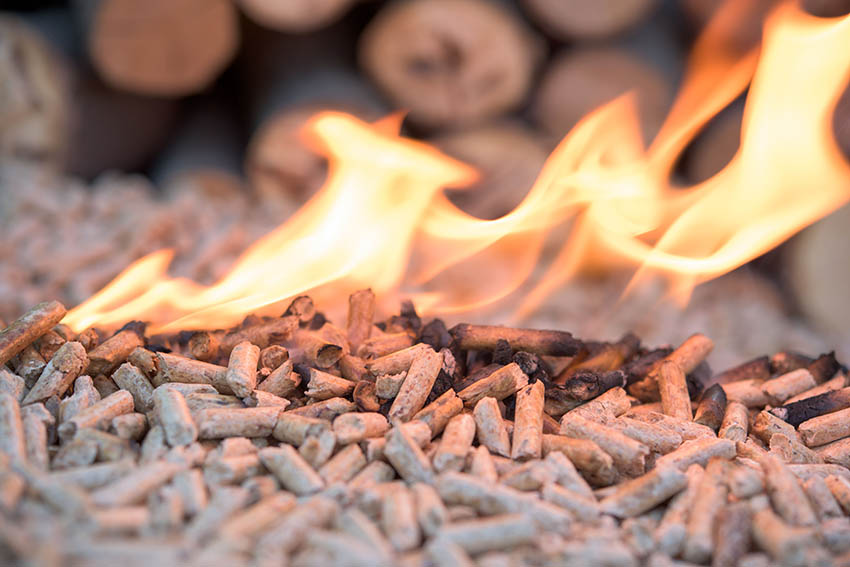
Biomass dust can be highly prone to self-ignition
There should be no more than 35 grammes of dust in a cubic meter of air (lower explosive limit) in the atmosphere immediately surrounding a biomass conveyor. Put into perspective, that is approximately the volume of a small tube of popular brand of children’s sweets. This means that conveyor design including dust extraction systems and chutes take on far greater importance. Strict conformity to Directive 94/9/EC (applicable to potentially explosive atmospheres of zones 20, 21 and 22 where combustible dust is present) should therefore be a pre-requisite.
The build-up of dust has to be kept to an absolute minimum. From a conveyor belt point of view, it is absolutely essential that the electrostatic dischargeability (anti-static) properties of the conveyor belt cover rubber (according to DIN EN ISO 284 test methods) do not exceed the maximum resistance value of 300 MΩ
Despite the claims of the manufacturers, not all rubber belts are sufficiently anti-static. A key ingredient used in good quality conveyor belt rubber is carbon black, which is an excellent electrical conductor. It is therefore extremely concerning that belting designed to compete in the lower price range end of the market will almost invariably contain either low grade carbon black (produced by burning scrap car tyres) and/or ‘fillers’ that are used as a cost-saving substitute.
It is important to bear in mind that it is NOT possible to obtain an ATEX certificate for a conveyor belt because belts are classified as a component. ATEX certification only applies to the whole conveyor. When sourcing conveyor belts for use in ATEX regulated areas it is very important to ask for a copy of a certificate provided by an appropriate independent testing authority such as the German Institute Dekra Exam GmBH.
Fire safety (self-extinguishing properties)
Factual evidence gained from laboratory testing as well as anecdotal evidence certainly indicates that even some of Europe’s biggest ports and terminals may be using belts that are not as resistant to fire as they are claimed to be. Only the best quality fire resistant belting for conveyors carrying biomass should be considered.
The first thing to bear in mind about fire proof rubber conveyor belts is that they do not exist. By its very nature, rubber and the fabric inner ply material (usually polyester & nylon) used to make conveyor belts is combustible. They will burn – end of story. The two descriptions used by conveyor belt manufacturers are “fire retardant” and, most commonly, “fire resistant”. However, in truth, a more accurate description would be “self-extinguishing”. This is because the ability of a conveyor belt to ‘resist’ fire is achieved by adding special chemicals and additives to the rubber compound during the mixing process. What actually happens when the rubber is ignited is that gases are emitted by the rubber which effectively starve the source of the flames of oxygen, thereby extinguishing the fire.
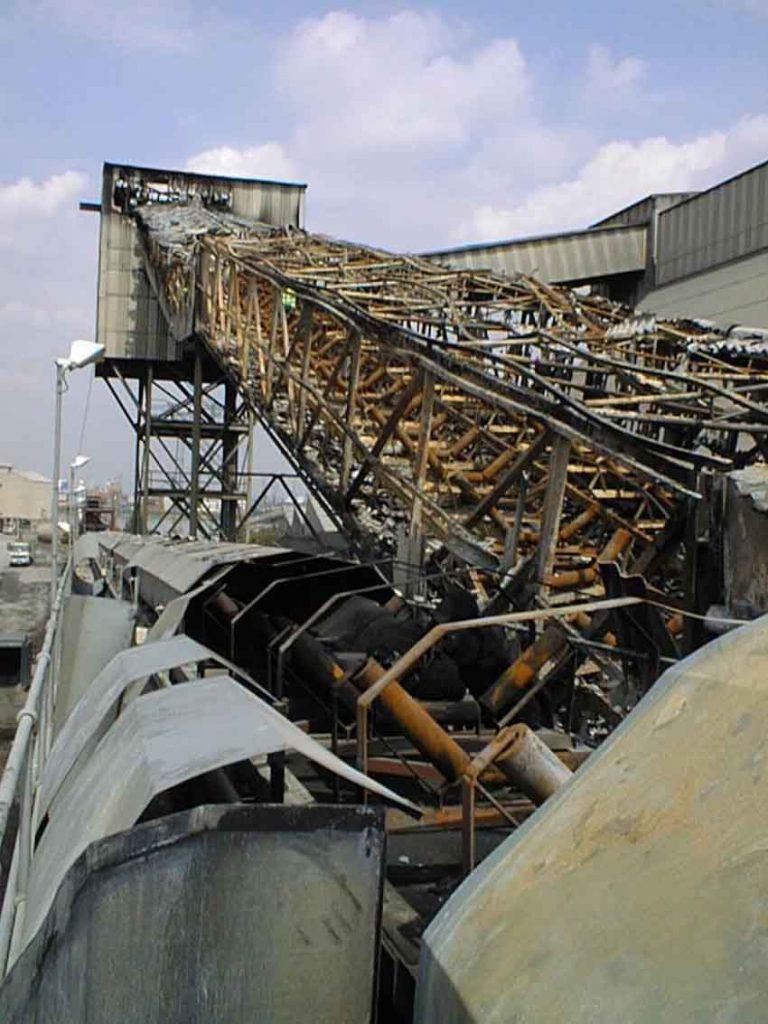
Every second counts. Conveyors carry fire at an alarming speed
If poor quality and/or insufficient amounts of the additives are used in the rubber compound then the ability to self-extinguish is slower and less effective. The time it takes for the belt to self-extinguish is enormously important because conveyors do what they are meant to do, which is to convey at speed; only this time it is conveying fire. This means that literally every second counts.
EN/ISO 340 testing
There are numerous safety classifications and international standards for which there are many different tests used to measure the self-extinguishing properties of conveyor belts but the basis of virtually all fire testing for belting used for bulk handling is EN/ISO 340.
This standard makes the distinction between fire resistance with covers and fire resistance with and without covers. The relevance of “with and without covers” is that wear reduces the amount of fire resistant rubber that protects the flammable carcass. Although no longer used in the current EN ISO 340, the market still commonly refers to grades ‘K’ for testing with covers and ‘S’ for testing with and without covers. This originates from DIN 22103 that was used as the basis during the creation of EN ISO 340.
The actual tests involve exposing six individual samples of belt to a naked flame causing them to burn. The source of the flame is then removed. The combustion time (duration of flame) of the test piece is recorded. A current of air is then applied to the test piece for a specified time after the removal of the flame. The flame should not re-ignite.
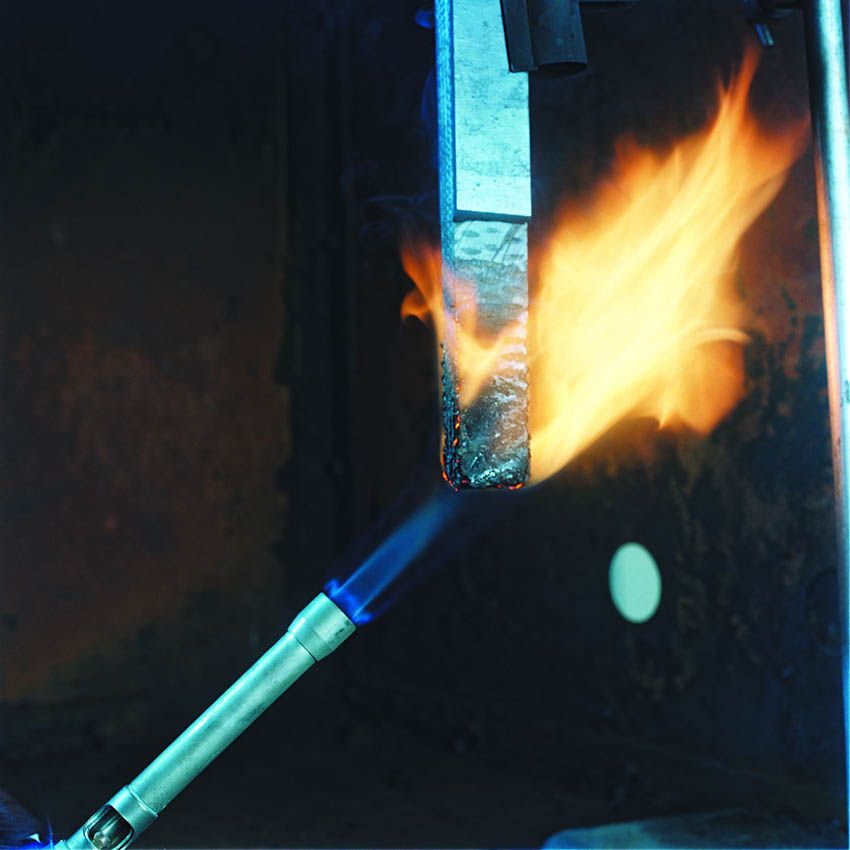
ISO 340 fire resistance test
The time it takes for each belt sample to self-extinguish after the fire source has been removed is precisely measured. This is the crucial aspect of the test because the duration of continued burning (visible flame) should be less than 15 seconds for each sample. The absolute maximum cumulative duration for each group of six sample pieces is 45 seconds. In other words, an average duration of less than 7.5 seconds per test sample.
Even if a manufacturer states that their fire resistant belt has passed the ISO 340 test, the buyer should still exercise caution. A typical conveyor belt can easily spread the fire more than 40 meters within 15 seconds.
Given the highly flammable nature of biomass, I recommend that ‘S’ grade (formerly EN 12882 Class 2B including anti-static requirements) be regarded as the minimum standard. A higher level of fire resistance is needed for conveyors that are used in enclosed areas. Here I recommend Class 4A of EN 12882, which includes an additional fire test.
Resistance to oils and resins
Biomass, especially the wood and wood waste content, can contain vegetable oils and resins that can have a very detrimental effect on the performance and life expectancy of a conveyor belt. When the oils and resins contained in biomass penetrate rubber it causes the rubber to swell and distort. This results in serious tracking and steering problems as well as premature wear. The oils, resins, fats and greases that have these damaging effects can be divided into two distinct sources – mineral and vegetable/animal.

The oil present in biomass can seriously distort even the thickest of conveyor belts
The level of oil and resin present depends very much on the type (origin) of the wood itself. For most wood from Scandinavia for example, good resistance to oil is necessary as these trees are mostly pine trees, which have high turpentine content. In South-European countries and in Latin America, Eucalyptus trees are commonly used. The wood from these trees contains little or no turpentine so oil resistance is not so essential. This is generally valid for non-pine wood such as poplar and birch. If the origin of the wood used for the biomass can be from variable sources then we would recommend the use of conveyor belts that have a combined resistance to fire and oil.
Oil resistance – test methods
There are two recognised test methods, both of which involve almost identical test procedures. These are ISO 1817 and the comparable, slightly less elaborate but very stringent American ASTM ‘D’ 1460. Samples of rubber (eg. 100mm X 1.6mm X 2mm strips for the ASTM test) are fully immersed in the relevant test liquid for a specific period of time. Rather surprisingly, ISO or DIN international performance standards for oil & grease resistance do not yet exist. Manufacturers are therefore at liberty to use whichever test conditions they deem most suitable to them. However, there is a sting in the tail concerning the matter of test methods.

ASTM ‘D’ testing
DIN 22102 G. Not what it seems.
Some of the biggest manufacturers of belting in the world, primarily those in Asia and in Europe use the DIN reference number 22102 G when referring to oil resistant belting. This can be very misleading because the letter ‘G’ is simply used to denote oil (or grease) resistant belting. The fact is that there are no firm requirements, test methods or limits specific to oil resistant belting associated with DIN 22102 G. This is a classic example of how the practice of using a test method reference number in order to give the end-user a false sense of security even though it is meaningless in respect to actual performance.
Ozone & UV resistance
The fourth essential characteristic of belting used to carry biomass may come as a surprise to some. It is the ability to resist the damaging effects of ground-level ozone and UV rays.
Ozone (O3) occurs naturally in the upper atmosphere, where it is formed continuously by the action of solar ultraviolet radiation on molecular oxygen (O2). At high altitude, ozone acts as a protective shield by absorbing harmful ultraviolet rays. Wind currents carry O3 to the atmosphere at the Earth’s surface. At low altitude, ozone becomes a pollutant. Ground level (or “bad” ozone) is not emitted directly into the air but is created by the photolysis of nitrogen dioxide (NO2) from automobile exhaust and industrial discharges. The effects are known as ozonolysis.
Even tiny traces of ozone in the air will attack the molecular structure in rubber. It also increases the acidity of carbon black surfaces with natural rubber, polybutadiene, styrene-butadiene rubber and nitrile rubber being the most sensitive to degradation. This can have several consequences such as surface cracking and a marked decrease in the tensile strength of the rubber.
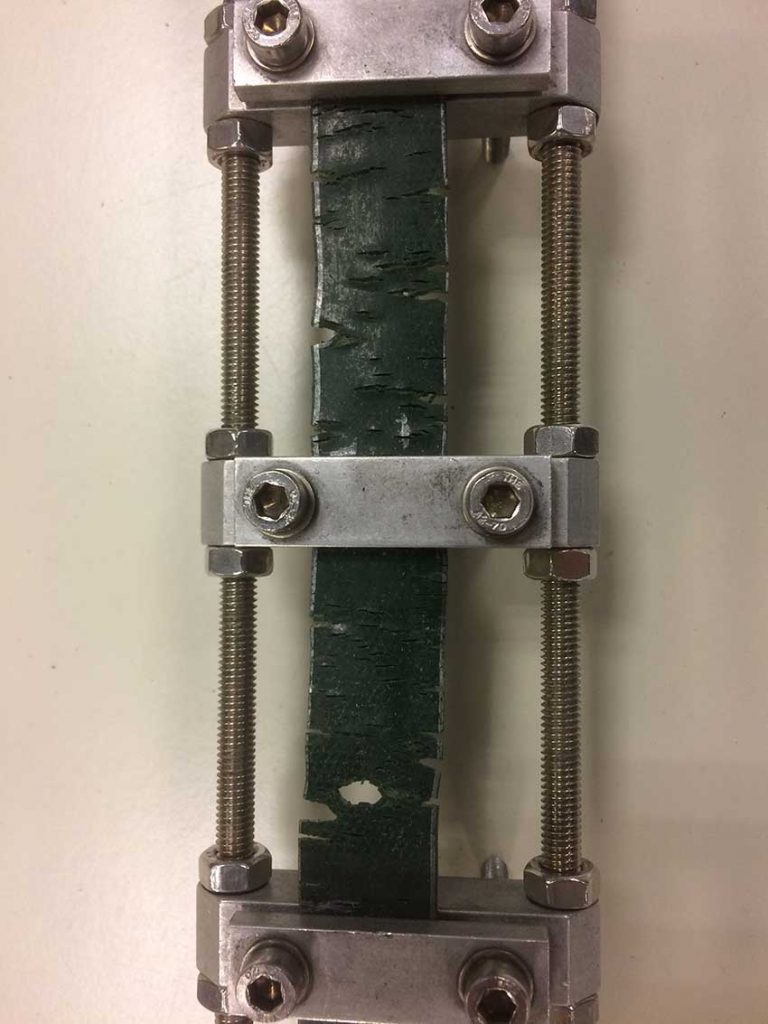
ALL rubber conveyor belts should be resistant to the effects of ozone & ultra violet light
Belts that do not operate under shelter and/or operate in coastal areas are especially prone to surface cracking. This can be extremely detrimental in terms of the performance of the belt and its working life. Even more significant are the environmental and health and safety consequences, especially when carrying biomass because the dust particles penetrate the surface cracks and are then discharged (shaken out) on the return (underside) run of the belt.
At first glance, fine cracks in the surface rubber may not seem to be a major problem but over a period of time the rubber becomes increasingly brittle. Transversal cracks deepen under the repeated stress of passing over the pulleys and drums and, if the conveyor has a relatively short transition distance, longitudinal cracks can also begin to appear. There are also hidden long-term effects such as moisture (including oils and resins from the wood waste) which seeps into the cracks and penetrate through the belt covers down to the carcass of the belt. The belt starts to distort and all sorts of difficult, expensive problems ensue.
To make matters worse, ‘bad’ ozone has a partner in crime that also has a seriously detrimental effect on rubber. Ultraviolet radiation causes chemical reactions to take place within rubber and the rapid decline in the ozone layer in the upper atmosphere over the past several decades is allowing an increasing level of UV radiation to reach the earth’s surface. Ultraviolet light from sunlight and fluorescent lighting accelerates deterioration because it produces photochemical reactions that promote the oxidation of the surface of the rubber resulting in a loss in mechanical strength.
EN/ISO 1431 international standards
The prevention of such problems is surprisingly easy because manufacturers can use special anti-oxidant additives when mixing their rubber compounds. These additives act as highly efficient anti-ozonants and provide protection against the damaging effects of ozone and ultra violet.
To scientifically measure resistance to ozone, samples are placed under tension (eg. 20% elongation) inside the ozone testing cabinet and exposed to highly concentrated levels of ozone for a period of time (eg: up to 96 hours).
Samples are closely examined for evidence of cracking at two-hourly intervals and the results carefully measured and recorded. Experience has determined that to be adequately resistant the pass criteria needs to be that the rubber sample does not show any signs of cracking after 96 hours (@ 40°C, 50 pphm and 20% strain) inside the ozone cabinet.
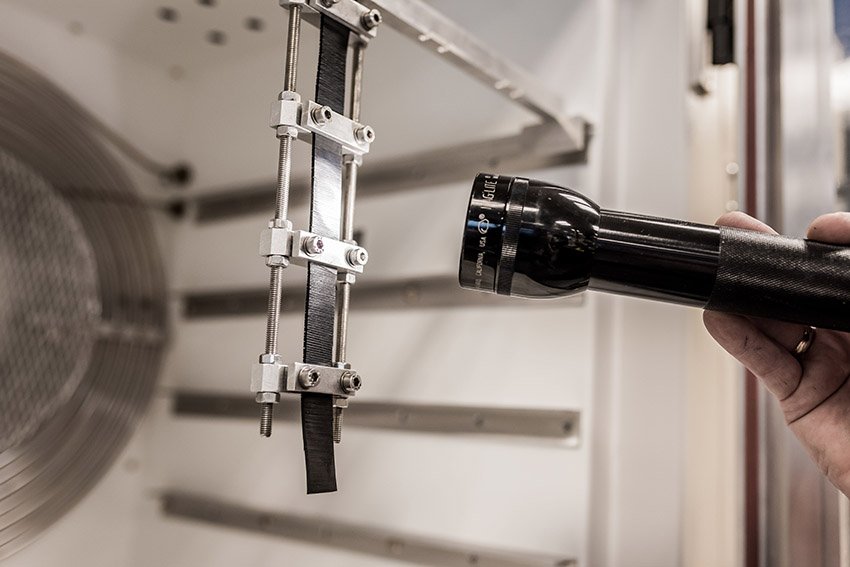
Samples are examined for evidence of cracking at two-hourly intervals
Despite its crucial importance, my research has revealed that ozone and UV resistance is very rarely, if ever, mentioned or, if it is mentioned, then only at a lower test and pass criteria. This is almost certainly because of the cost of the anti-ozonants that need to be used during the rubber compound mixing process. My advice is to make ozone & UV resistance a constant requirement when selecting any rubber conveyor belts, especially for those intended for to be used to convey biomass.
Be sure of what you are buying
End-users are effectively required to rely on the honesty and integrity of the trader who in turn is reliant on the honesty and integrity of a manufacturer who may well have their own interpretation of test methods and quality standards. European conveyor belt manufacturers could also justifiably argue that they are at a disadvantage. Interestingly but somewhat worryingly, with only one notable exception as far as I can tell, all European-based belt manufacturers import and re-sell belting under their own brand name to supplement their overall output. This allows them to be more competitive on price.
Check twice – buy once
When it comes to buying belts for conveying biomass, anything less than the very highest standard can prove to be an extremely dangerous and costly mistake. It is always best practice to demand a certificate of origin stating the belt’s true provenance as well as documented confirmation of the belt’s anti-static properties; its resistance to fire, oil, abrasive wear and ozone & UV as the fundamental requirements.
Author: Leslie David

After spending 23 years in logistics management, Leslie David has specialised in conveyor belting for over 15 years. During that time, he has written numerous technical guidance features and papers and has become one of the most published authors on conveyor belt technology in the World.

